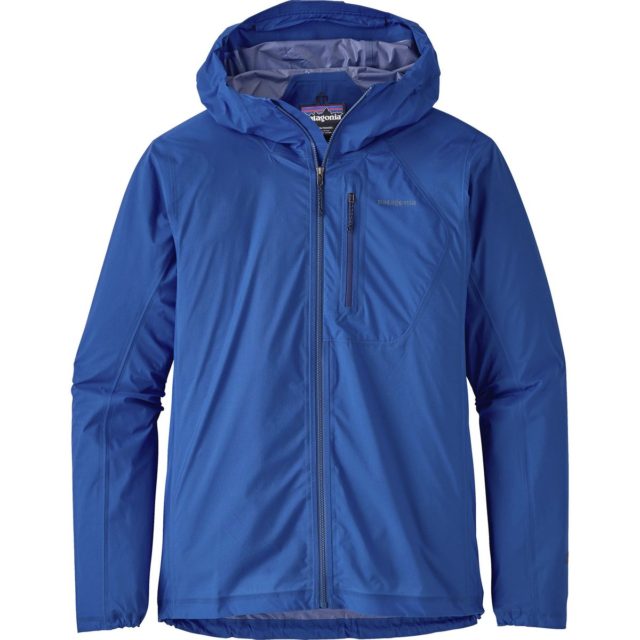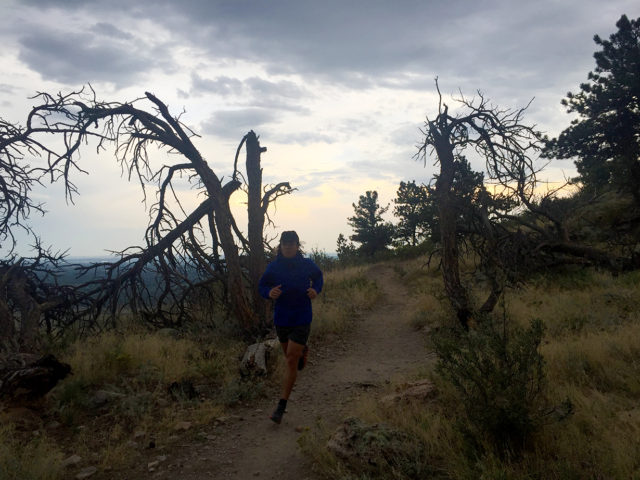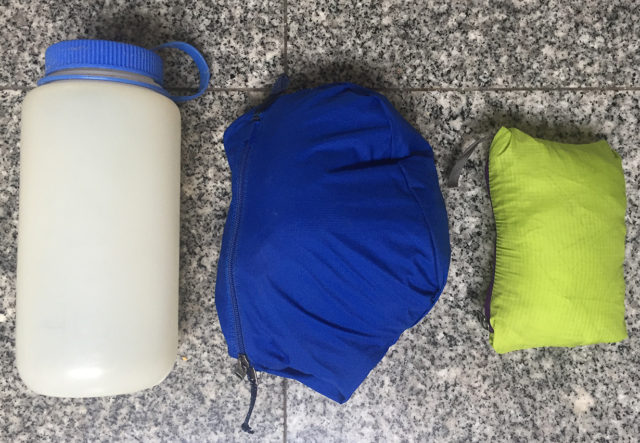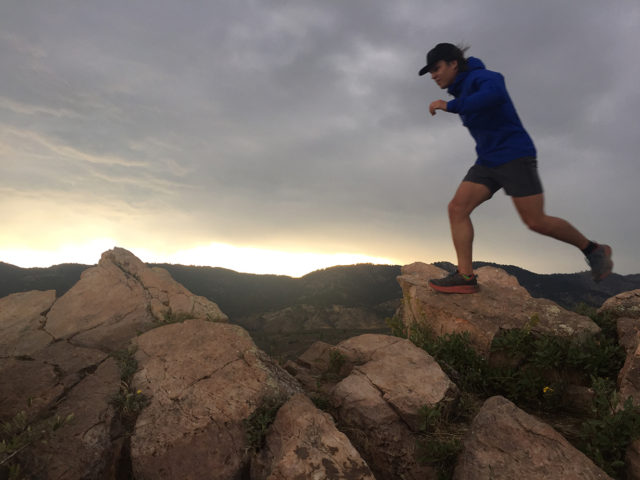
Patagonia Storm Racer Jacket
Reviewers:
- Sam Shaheen: 5’10”, 140 lbs
- Luke Koppa: 5’8”, 155 lbs
Size Tested: Medium
Blister’s Measured Weight: 175 grams
Material: H2No® Performance Standard shell: 3-layer, 1.74-oz 12-denier 100% nylon ripstop with a 7-denier tricot backer, waterproof/breathable barrier and a DWR (durable water repellent) finish
Stated Features:
- Featherweight H2No® Performance Standard 100% nylon ripstop keeps you dry, while a tricot backer wears soft and comfortable next to your skin
- Zippered chest pocket converts to stuffsack with a reinforced carabiner clip-in loop
- Hood adjusts in one pull for ease of use and good peripheral vision
- Durable half-elastic cuffs lay flat against top of wrists for low bulk and superior comfort; elastic at back hem allows jacket to lie flat against body while sealing out weather
- Reflective logo on left chest and center back at neck
- Perfect for use over baselayers and light midlayers
Pockets:
- 1 chest pocket (zippered)
MSRP: $249
Test Locations: Fort Collins, Rocky Mountain National Park, & Cameron Pass, CO
Days Tested (total): 14
Intro
The Storm Racer is Patagonia’s trail-running-oriented ultralight rain shell, and it comes in at an impressively low weight of 175 grams for a size Medium. Sam Shaheen and I have both spent some time in the Storm Racer, and have come away with the conclusion that this jacket is much more versatile than you might initially think. Read more to find out why.
Here’s what Patagonia says about the Storm Racer:
“A mountain running essential. The Storm Racer is a UTMB-inspired and approved 3-layer, featherlight, pared-down 100% nylon ripstop shell, with a supple feel and a tricot backer that remains comfortable next to skin at mile 100. The jacket features minimal-adjust half-elastic cuffs (low bulk, high comfort), a close-fitting single-pull hood that rolls away and a self-stuffing chest pocket (with carabiner clip-in loop). With reflective logos at left chest and back of neck. Bells, whistles and excess fluff not included.”
Patagonia’s description of the Storm Racer is succinct and accurate. However — and this does not happen very often — we think their description actually sells the jacket a bit short. While we have been running in the Storm Racer (and it’s performed very well in this context), we’ve also been using it for more than that, and have found it to be very useful well beyond the singletrack.
Fit
Luke Koppa (5’8”, 155 lbs): The size Medium Storm Racer fits me very well. It is definitely pretty slim, but with enough room that I never felt restricted while running in it. Compared to the Patagonia Houdini, the Storm Racer is a bit longer and slightly roomier. The Storm Racer is slightly longer than I’d prefer for a dedicated-running shell, but I’m also on the shorter side for most Mediums and I don’t really mind the slightly longer fit.

Sam Shaheen (5’10”, 140 lbs): I agree with Luke, the Storm Racer’s extra length, however, is one of the factors that makes it more versatile than just a running piece. For me, the Storm Racer’s fit is about perfect for a minimal jacket. There is enough room to layer lightly underneath, while at the same time, the Storm Racer is slim enough to not get in the way or be overly susceptible to errant breezes.
Materials
Luke: Unlike many ultralight rain shells that use 2.5-layer laminates, the Storm Racer uses a full 3-layer H2No waterproof / breathable laminate, and features a comfortable, supple tricot backer. The result? This jacket is way more comfortable on skin compared to the sticky-feeling 2.5-layer options on the market.
The tricot backer makes the Storm Racer feel a bit less clingy than most other shells, even when I get really sweaty. I’ll still only wear the Storm Racer on really wet and / or cold runs, but after I’ve started sweating, I don’t notice the jacket as much as I do with all 2.5-layer, and even other 3-layer shells.
The Storm Racer is not as comfortable on skin compared to non-waterproof fabrics like the stretch-woven soft shell of the Strafe Recon Jacket, but compared to other fully waterproof jackets, the Storm Racer has one of the most comfortable fabrics I’ve used.
Sam: Yep, I agree with Luke. 2.5-layer pieces just feel pretty awful against the skin. Though you definitely pay for it (the Storm Racer costs $249), the 3L layup on the Storm Racer is very comfy against the ski, which is important in a piece that I often pair with short-sleeved base layers, and therefore tend to have skin contact on the inside of the shell.
Features
Luke: This is a stripped-down, minimalist shell, so it’s unsurprisingly not loaded with features. However, the features it does have are pretty dialed.
The Storm Racer has one chest pocket that closes with a water-resistant zipper and includes a carabiner loop for attaching the jacket to a harness or pack when it’s stuffed into the pocket. The pocket can snugly fit a smartphone, bar, wallet, etc., and the contents don’t bounce around very much while running.
I really like the cuffs on the Storm Racer, which are similar to those on the Houdini. The cuffs use elastic only on the underside of the wrist and feel secure and comfortably tight, but lay flatter on my wrists compared to cuffs that use velcro closures. The Storm Racer’s cuffs can fit over light gloves, though it’s a stretch to get them over bulkier ski gloves.

Apart from the chest pocket and cuffs, the Storm Racer has a single adjustment on the non-helmet-compatible hood that keeps it in place and doesn’t restrict much vision. It’s simple, effective, and light. Nice.
Lastly, the Storm Racer has a fixed, non-adjustable elastic section on the back of the hem that keeps the jacket close to my body. Like the Storm Racer’s semi-elastic cuffs, the jacket’s hem stays secure and doesn’t leave any cordlocks flailing around while running.
Weight
Luke: At 175 grams for a Medium, the Storm Racer is impressively light. The Patagonia Houdini has a stated weight of 102 grams, so for only around 70 grams more, you get a fully waterproof jacket that still feels very comfortable on skin.
For reference, here are some weights (in grams) for a few notable pieces:
102 Patagonia Houdini Jacket, size Medium (stated weight)
125 Arc’teryx Norvan SL Hoody, size Medium (stated weight)
175 Patagonia Storm Racer Jacket, size Medium (measured weight)
180 Outdoor Research Helium II Jacket, size Large (stated weight)
201 Patagonia Alpine Houdini Jacket, size Medium (stated weight)
215 Arc’teryx Norvan Jacket, size Medium (stated weight)
Packed Size
Luke: The Storm Racer stuffs easily into its single chest pocket. Packed down, it’s about twice as large as the Houdini. However, it’s still only about the size of a grapefruit, and can easily be crammed into even my most minimalist running vests (e.g., the Salomon S/Lab Sense Ultra 5 Set).

Weather Resistance
Luke: So far, I’ve had zero issues with water penetrating the fabric of the Storm Racer. Its DWR has worked very well and has maintained performance after a few washes. No complaints here — this rain jacket does its job when it comes to water resistance.
I also haven’t noticed any wind coming through the Storm Racer, which is what I’d expect of a 3-layer, non-air-permeable waterproof jacket. In colder temps where breathability isn’t as important, the Storm Racer works just fine as a windbreaker.
Sam: After taking the Storm Racer out in some heavy rain and snow, I’ve been quite impressed by its weather resistance. Just like its heavier 3L counterparts, the Storm Racer blocks all the wind and precip mother nature can throw at it.
Breathability
Luke: The Storm Racer uses a pretty standard waterproof / breathable membrane (Patagonia’s proprietary H2No), so it isn’t the most breathable jacket. If I’m running in it in temperatures over ~40°F, I start to sweat pretty quickly.
However, while the Storm Racer isn’t super breathable, it is more comfortable than most shells once you start sweating, thanks to its tricot liner. And since, if I’m running in it, I’ll start sweating pretty fast in any sort of waterproof jacket (even more breathable air-permeable options), on-skin comfort is more important to me than ultimate breathability for running shells.

Sam: I think it’s important to note that, although the Storm Racer doesn’t breathe as well as air-permeable hard shells or softshells, it certainly does better than pricepoint 2.5L fabrics like Gore-Tex Paclite, or the many other proprietary 2.5L membranes on the market. As an emergency shell, this piece does a pretty good job of keeping up with my sweat — especially given its weight.
Durability
The Storm Racer is a minimalist piece with a very thin fabric, so we’ve purposefully been careful with it. And if you try to not rub it up against too many rocks or run into too many trees, it should hold up just fine. The Storm Racer’s 3-layer fabric is a bit heftier than the Houdini’s fabric, and I’d expect it to hold up a slightly better than similarly ultralight 2.5-layer shells (3-layer fabrics tend to have better long-term durability than 2.5-layer options). So far, we have no durability issues to report, but we’ll update this review if anything arises in the future.
Cost
I think the main thing holding back the Storm Racer is its price. At $249, it’s definitely more expensive than most 2.5-layer ultralight shells. However, for that bump up in price, you’ll get a far more comfortable jacket, and you should get a longer life out of it thanks to 3-layer fabrics’ increased long-term durability. If you only plan on using your ultralight shell for short periods of time and / or for low-output activities, you’ll be fine with a less expensive option. But if you value on-skin comfort, the Storm Racer is worth considering, and we also suspect that it will hold up better over time than 2.5-layer shells.
Who’s It For?
Luke: If you’re looking for an ultralight rain shell for running, the Storm Racer is a great choice. It’s waterproof, packs down very small, and feels more comfortable on sweaty skin than most of the competition.
However, the Storm Racer also makes a whole lot of sense as an emergency rain shell, especially if you value low weight and small packed size. I love ski touring in non-waterproof soft shells due to their increased breathability, and I feel more comfortable doing so when I know I’ve got waterproof protection tucked away in my pack in the form of the Storm Racer. When it comes to using the Storm Racer as an all-around, do-everything shell, it could work, but its minimal feature set and thin fabric mean it’s not the best option for this sort of use.
Sam: As an emergency shell, the Storm Racer stands out for its versatility. In the spring, I wear a soft shell jacket as my main protection, but stash the Storm Racer in case the weather throws a curveball. Similarly, in summer, the Storm Racer is always at the bottom of my pack to deal with the fickle weather of Colorado. In the Fall, I take the Storm Racer on all of my alpine climbing and hiking excursions for the same reason. I only tend to leave it in the closet during winter — a full-blown hardshell tends to be the better choice when dealing with colder temps and potentially harsh conditions.
Bottom Line
For such a lightweight, minimal piece, the Patagonia Storm Racer is surprisingly versatile. It excels as a running shell thanks to its sleek fit, waterproof fabric, and on-skin comfort. At the same time, it also works very well as a “just in case” shell that won’t take up much space in your pack. If you’re looking for an ultralight rain shell, whether for running or to keep stashed in your pack for emergencies, we highly recommend the Storm Racer.
